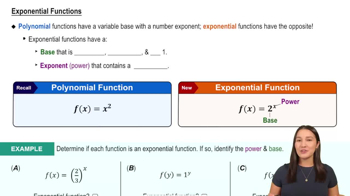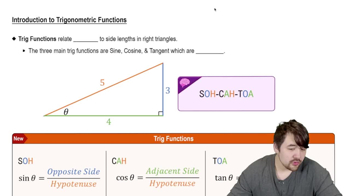Table of contents
- 0. Functions7h 52m
- Introduction to Functions16m
- Piecewise Functions10m
- Properties of Functions9m
- Common Functions1h 8m
- Transformations5m
- Combining Functions27m
- Exponent rules32m
- Exponential Functions28m
- Logarithmic Functions24m
- Properties of Logarithms34m
- Exponential & Logarithmic Equations35m
- Introduction to Trigonometric Functions38m
- Graphs of Trigonometric Functions44m
- Trigonometric Identities47m
- Inverse Trigonometric Functions48m
- 1. Limits and Continuity2h 2m
- 2. Intro to Derivatives1h 33m
- 3. Techniques of Differentiation3h 18m
- 4. Applications of Derivatives2h 38m
- 5. Graphical Applications of Derivatives6h 2m
- 6. Derivatives of Inverse, Exponential, & Logarithmic Functions2h 37m
- 7. Antiderivatives & Indefinite Integrals1h 26m
- 8. Definite Integrals4h 44m
- 9. Graphical Applications of Integrals2h 27m
- 10. Physics Applications of Integrals 2h 22m
4. Applications of Derivatives
Motion Analysis
Problem 3.6.59a
Textbook Question
A woman attached to a bungee cord jumps from a bridge that is 30 m above a river. Her height in meters above the river t seconds after the jump is y(t) = 15(1+e-t cos t), for t ≥ 0.
Determine her velocity at t = 1 and t = 3.
 Verified step by step guidance
Verified step by step guidance1
To find the velocity of the woman at a given time, we need to determine the derivative of her height function y(t) with respect to time t. The derivative, y'(t), represents the velocity.
The height function is given as y(t) = 15(1 + e^(-t) * cos(t)). We will apply the product rule and chain rule to differentiate this function.
First, identify the components of the function: u(t) = e^(-t) and v(t) = cos(t). The product rule states that the derivative of u(t) * v(t) is u'(t) * v(t) + u(t) * v'(t).
Calculate the derivatives: u'(t) = -e^(-t) (using the chain rule for e^(-t)) and v'(t) = -sin(t) (derivative of cos(t)).
Substitute these derivatives into the product rule formula: y'(t) = 15 * [(-e^(-t) * cos(t)) + (e^(-t) * (-sin(t)))]. Evaluate y'(t) at t = 1 and t = 3 to find the velocity at these times.
 Verified video answer for a similar problem:
Verified video answer for a similar problem:This video solution was recommended by our tutors as helpful for the problem above
Video duration:
5mPlay a video:
Was this helpful?
Key Concepts
Here are the essential concepts you must grasp in order to answer the question correctly.
Differentiation
Differentiation is a fundamental concept in calculus that involves finding the derivative of a function. The derivative represents the rate of change of the function with respect to its variable, which in this case is time. To determine the velocity of the woman at specific times, we need to differentiate her height function y(t) with respect to t, yielding the velocity function v(t).
Recommended video:

Finding Differentials
Exponential Functions
Exponential functions are mathematical functions of the form f(t) = a * e^(bt), where e is Euler's number. In the given height function y(t), the term e^(-t) indicates that the height changes exponentially over time. Understanding how exponential decay affects the height is crucial for accurately calculating the velocity at different time points.
Recommended video:

Exponential Functions
Trigonometric Functions
Trigonometric functions, such as sine and cosine, are periodic functions that relate angles to ratios of sides in right triangles. In the height function y(t), the cosine term introduces oscillatory behavior to the height over time. Recognizing how the cosine function influences the overall height is important for evaluating the velocity at specific moments during the jump.
Recommended video:

Introduction to Trigonometric Functions

 6:29m
6:29mWatch next
Master Derivatives Applied To Velocity with a bite sized video explanation from Nick
Start learning




